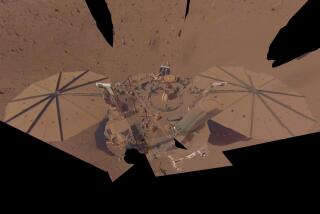Charting the Marvels of Mars
Almost 4 billion years ago, an asteroid slammed into the southern hemisphere of Mars. Even today, the scar of that primordial impact remains the largest crater in the solar system.
But not until NASA’s Mars Global Surveyor completed the first detailed topographical map of the planet’s surface earlier this spring were scientists able to appreciate the true dimensions of that ancient collision.
The Hellas crater on Mars is so deep it could easily swallow Mt. Everest. The spray of debris radiating from the impact covers an area the size of the continental United States with a blanket of material two miles thick, stretching 2,500 miles across.
The topographical particulars of the crater itself--6 miles deep and 1,300 miles across--are among many surprising revelations from a new, highly accurate surface map of Mars. The panorama is based on 27 million elevation measurements gathered in March and April from the Mars Orbiter Laser Altimeter aboard the Global Surveyor spacecraft, which is orbiting 229 miles above the red planet.
“Probably the most unexpected finding was how much the Hellas impact basin dominates the topography of the southern hemisphere,” said Maria Zuber, a planetary scientist at the Massachusetts Institute of Technology and one of the 20 scientists who created the global grid of Mars.
In creating a high-resolution, three-dimensional map of the Martian terrain, the researchers--working with NASA’s Goddard Space Flight Center in Greenbelt, Md., and the Jet Propulsion Laboratory in Pasadena--scaled the heights of the tallest mountains and plumbed the depths of the deepest craters on any planet in the solar system.
Indeed, the new map reveals that Mars has the highest, lowest and smoothest land forms anywhere in the solar system.
Between the loftiest and the lowest points on Mars, there is 19 to 20 miles difference in elevation--1 1/2 times the range of elevation seen on Earth. It is a testament to the strength of the underlying crust of Mars that it can support such weight.
The Olympus Mons volcano, for example, rises nearly 17 miles above the average elevation of Mars, making it the tallest known volcano in the solar system.
The broad outlines of such Martian geography have long been known but never before has the planet’s surface been revealed in such precise detail.
“This incredible database means that we now know the topography of Mars better than many continental regions on Earth,” said Carl Pilcher, science director for solar system exploration at NASA headquarters in Washington, at a recent briefing on the topographical map.
“This is affecting significantly the way we interpret Mars,” said project principal investigator David Smith at Goddard. “This new data really gives us a chance to try to understand the evolution of the planet.”
Matthew Golombeck, an expert in Martian tectonics at JPL who is using the data to study the planet’s internal volcanics, called the new map “spectacular,” in part because the data upon which it is based are so reliable.
“The best thing about this data set is that it is all good,” Golombeck said. “You can trust every drop of it. You don’t have to worry about any uncertainties.”
To map the rise and fall of surface features, the spacecraft beams an infrared laser pulse at the surface every tenth of a second and then calculates the time it takes for the light to bounce back to a receiver.
By clocking the time interval, the device can determine how far the light traveled and, thus, the elevation of the surface below, with an accuracy of about 6 feet over flat, smooth surfaces, and about 42 feet elsewhere.
It performs that operation 900,000 times a day, continuously relaying its findings back to Earth.
The new data document a striking contrast in elevation between the two halves of the planet; the surface in the south is on average 3 miles higher than that in the north.
“The most curious aspect of the topographic map is the striking difference between the planet’s low, smooth northern hemisphere and the heavily cratered southern hemisphere,” Smith said.
“Something went on in the northern hemisphere. Many of the craters have been covered up, washed away or somehow resurfaced,” he said. “Whether this was caused by water in the form of an ocean we are not sure. But we can’t rule that out for now.”
Surely, the researchers said, that pronounced north-south slope across such a broad expanse of the Martian surface would have influenced the way water flowed early in the planet’s history. Three-quarters of the Martian surface would have drained into the northern lowlands.
The map also shows other, smaller areas, such as within the 2,400-mile-long Valles Marineris canyon system, where Mars’ limited water supply may have pooled.
Zuber said the northern basin “is consistent with the formation of a past ocean.”
“The north basin is the smoothest surface known in the solar system,” she said. “Any water on Mars would have flowed into the area that is low and smooth.”
No one knows whether Mars ever had enough free-flowing water to fill the basin, but the extent of such topography does give the scientists one more clue to how much water may have once existed.






